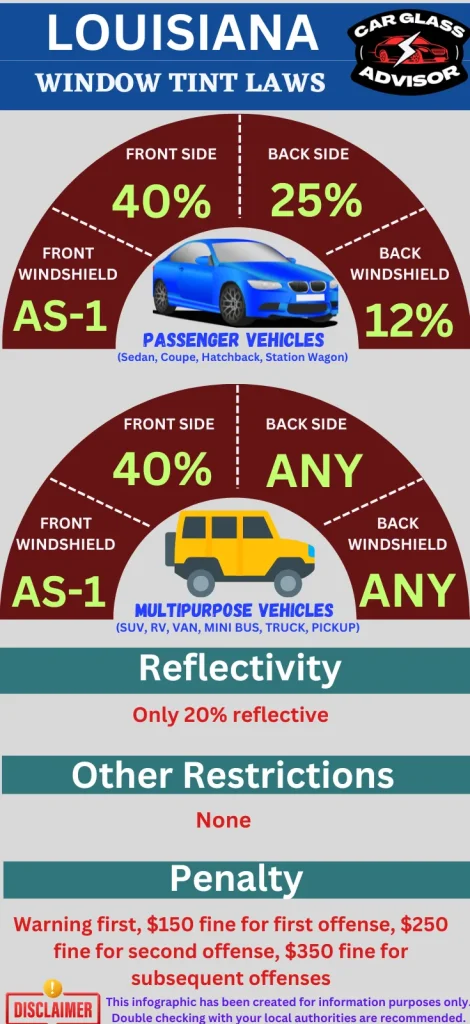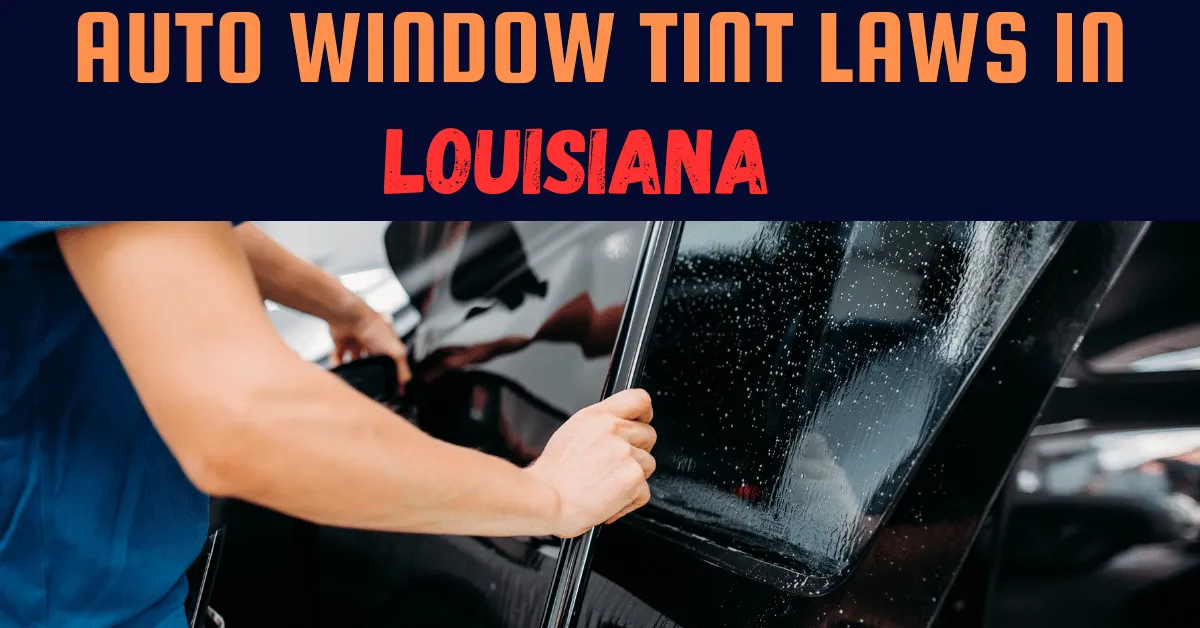Louisiana has had car window tinting laws in place since 1993, so drivers need to be aware of the state’s regulations for the darkness and reflectivity of their car’s tint. To avoid any potential fines, it’s crucial to understand all the rules and regulations surrounding car window tinting in Louisiana. Luckily, I’ve got you covered with all the information and documents to ensure that you stay within the legal boundaries. So take the time to read through the details below, and you’ll be good to go!
Visible Light Transmission (VLT) and Visible Light Reflection (VLR) are TWO crucial concepts to consider if you’re planning to tint your car windows. In this discussion, I’ll explain both concepts, starting with VLT.
1. Window Tint Darkness in Louisiana (VLT)
Window Tint Darkness or Visible light transmission (VLT) is a measure of the amount of light that passes through a film. It’s measured in percentages and can diverge from 0% to 100%. The higher the percentage, the more visible light is transmitted through the film.
Every state has definitive legal limitations. Therefore, if you’re driving in Louisiana, it’s important to note that the amount of light allowed to pass through tinted windows may differ from other states, as well as between passenger and multi-purpose vehicles. To avoid any confusion or potential legal issues, it’s essential to carefully review Louisiana’s specific tinting laws. Make sure you take the time to understand the details of these regulations, so that you can ensure your car’s tinting is within the legal limits. Don’t risk facing fines or penalties for non-compliance – stay informed and drive with confidence.
Tint darkness laws for passenger vehicles (sedans) in Louisiana:
Windshield: You can use a non-reflective tint above the manufacturer’s AS-1 line or top 5 inches.
Front Side windows: You can use maximum up to 40% tint darkness.
Back Side windows: You can use a maximum 25% tint darkness for backside windows.
Rear Window: You can use maximum 12% tint darkness for rear windows.
Tint darkness laws for multi-purpose vehicles (SUVs and vans) in Louisiana:
Windshield: You can use a non-reflective tint above the manufacturer’s AS-1 line or top 5 inches.
Front Side windows: You can use up to 40% tint darkness for front side windows.
Back Side windows: You can use any tint darkness for backside windows.
Rear Window: You can use any tint darkness for rear windows.
2. Window Tint Reflection in Louisiana (VLR)
Window Tint Reflection or Visible light reflection (VLR) is the amount of light that a window film reflects. For car window tinting in Louisiana, it’s also important to remember that the VLR (visible light reflection) percentage plays a significant role. The VLR is measured as a percentage, ranging from 0% to 100%, with a lower percentage showing less visible light reflecting into the vehicle. This, in turn, means that more sunlight will be blocked. As such, it’s essential to pay attention to the VLR percentage allowed by Louisiana’s window tint laws. So, take note of this crucial factor to stay on the right side of the law.
Tint reflection laws for passenger vehicles (sedans) in Louisiana:
Front Side windows: Window tint installed on the front side windows of a passenger vehicle must not be more than 20% reflective.
Back Side windows: Window tint installed on the back side windows of a passenger vehicle must not be more than 20% reflective.
Tint reflection laws for multi-purpose vehicles (SUVs and Vans) in Louisiana:
Front Side windows: Window tint installed on the front side windows of a multipurpose vehicle must not be more than 20% reflective.
Back Side windows: Window tint installed on the backside windows of a multipurpose vehicle must not be more than 20% reflective.
Other Louisiana Window Tint Rules and Regulations:
Window tinting in Louisiana is no joke, as the state has a strict set of rules and regulations that drivers must follow. In addition to maintaining a specific percentage of darkness and glare on each window, there are other important regulations that you need to be aware of. These rules and regulations cover various aspects of window tinting, from the type of tint you use to the location of the tint on your car windows. It’s essential to adhere to all of these guidelines to avoid any potential legal trouble. So, take a look at some of the other rules and regulations you need to follow when tinting your car windows in Louisiana.
Side Mirrors: In Louisiana, there are no specific regulations regarding side mirrors in relation to window tinting laws. The regulations in Louisiana only stipulate the minimum light transmission required on all windows, and mention nothing about side mirrors. However, it’s important to note that all vehicles in Louisiana must comply with the state’s regulations regarding window tinting, which specify the minimum level of light transmission required on all windows. This means that regardless of the level of tint on your side mirrors, if your vehicle’s windows do not meet the legal light transmission requirements, they are considered illegal.
Restricted Colors: In Louisiana, there is restriction on the colors of window tint that can be used on a vehicle in Louisiana. According to the state law, Red or amber color tints are not permitted on any vehicle windows.However, you can use gray, green, bronze, and neutral smoke colors on your vehicle’s windows with no issue. It’s important to note that all vehicles in Louisiana must comply with the state’s regulations regarding window tinting, which stipulate the minimum light transmission required on all windows.
Certificates: Manufacturers of the film must certify the film they sell in the Louisiana state. The address and the name must clearly be seen on that certificate. Drivers must be able to show the certificate when asked, so it is sensible to keep it with them at all times.
Stickers: Louisiana State law also requires tint film installation companies must also give the vehicle’s owner a sticker or certificate with their name and address.
Medical Exceptions: In the state of Louisiana, there are no medical exemptions that would allow the use of special tint on a vehicle. According to state law, all vehicles must comply with the regulations regarding window tinting, which stipulate the minimum light transmission required on all windows, regardless of any medical conditions that the vehicle owner may have. This means that if a person has a medical condition that would benefit from the use of special tint, they must still comply with the state’s regulations regarding window tinting.
Penalties For Non-Compliance: In Louisiana, if a vehicle is found to have illegal window tinting, the penalties can include fines. According to state law, if a vehicle is found to have illegal window tinting, the vehicle owner will typically be given a warning to have the tint removed or replaced with legal tint. If the vehicle owner does not comply with the warning and fix the issue within the given time frame, they may be subject to fines. The fines for illegal window tinting in Louisiana can vary depending on the number of offenses. For a first offense, the fine is $150, for a second offense it is $250, and for any subsequent offenses, the fine is $350.

Conclusion
The 2023 Louisiana window tint law declares that the legal limits for a sun screening device (window tint) on a passenger car are: non-reflective tint above the manufacturer’s AS-1 line for windshield, 40% light transmission for the front side windows, 25% light transmission for the rear side windows, and 12% light transmission for the rear windshield. This means that the tint on the front side windows of a passenger car must allow at least 40% of the light to pass through, the tint on the rear side windows must allow at least 25% of the light to pass through, and the tint on the rear windshield must allow at least 12% of the light to pass through. It is important to note that these are the legal minimums and you may choose to have a lighter tint on your windows if you wish to. It is also important to note that vehicles other than passenger cars may have different regulations, so it is always a good idea to check with local authorities to ensure compliance with all applicable laws and regulations.
Disclaimer
The information on this site is provided for informational purposes only and should not be construed as legal advice or as a substitute for the advice of an attorney. No user of this site, or any other person or entity that may have received this information, shall rely upon the information contained as creating an attorney-client relationship between such user and Car Glass Advisor. The rules and regulations pertaining to car window tint in Louisiana may change at any time. Therefore, please contact a local lawyer licensed to practice in your jurisdiction.

